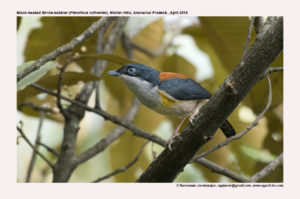
Black-headed Shrike-babbler Pteruthius rufiventer.
Etymology:
- Pteruthius : Greek word pteron -wing; eruthaino- to dye red { Red Winged}
- Rufiventer: :Latin word Rufi- Rufous: Venter – Belly { Rufous bellied}
Distribution in India: Resident of Himalayas and North East hills of India.
Description: Size of 18·5–20 cm; Wt. of 32–48 g. It is a large shrike-babbler. The male of nominate race has crown, nape and head side ,lores, cheek and ear-coverts as black with dark blue-green gloss, upperparts are chestnut; upperwing is black, chestnut tips on tertials, tail is black but with chestnut tips; chin and upper submoustachial area are white, shading to pale grey on lower submoustachial area to mid-breast, cutting abruptly to brown-tinged pale pinkish on belly. The breast side has dull yellow patch; iris is blue-grey to purplish-black, orbital skin is grey; upper mandible is black to dusky, lower mandible is pale grey or blue-grey; legs are pale pinkish-brown to chocolate-brown. The female has a black crown with mid-grey streaks, all-black nape, yellow-tinged olive-green upperparts. The wing fringes and central tail are yellow-tinged olive-green, black primary coverts, chestnut rump and tips of tertials and tail are chestnut; mid-grey head side and neck side, becoming slightly paler on breast, lower underparts are darker than on male, with only vague yellowish stain on breast side. The juvenile male has crown and nape duller, tinged brown, mantle mixed with yellowish-green feathers.
Habitat: It is found in broadleaf evergreen forest, including mature mixed moss-covered oak and mixed oak-rhododendron, occasionally secondary growth and bamboo. It is found from 1600 -2400m.
Food Habits: It eats insects, including weevils and other beetles and caterpillars. It occurs singly, in pairs or in small parties, sometimes in association with other species, including other babblers, in mixed feeding flocks. It is lethargic and rather slow-moving. It forages usually quite high up in trees, in canopy and upper middle storey, but sometimes quite low down in undergrowth.
Breeding Habits: They breed in Apr in Bhutan.